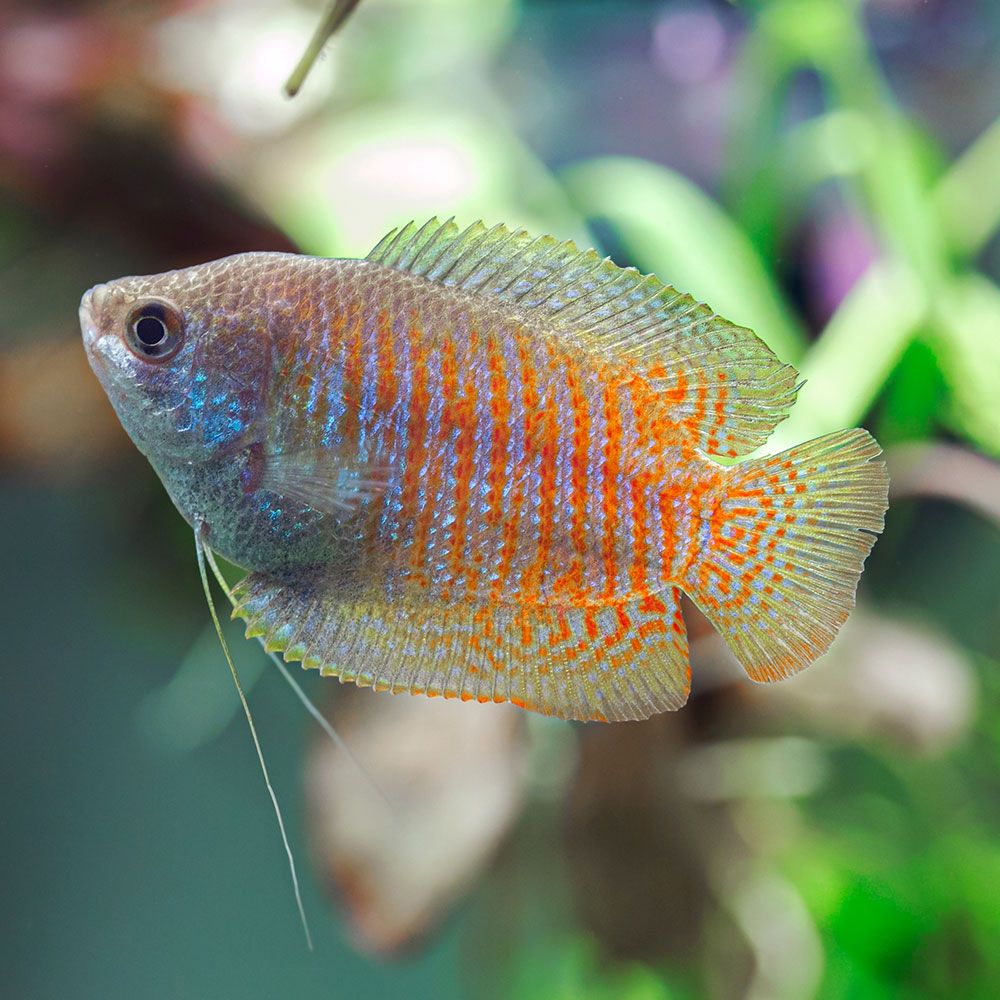If you want to add an easy-to-care fish to your freshwater tank that will enchant you with its colors, look no further than dwarf gourami.
The species is excellent for peaceful community tanks. It can be a pretty rewarding experience to raise and breed these, whether you’re a beginner or have some experience in the aquarium hobby.
Intrigued to know more? Let’s dive straight into it!
What is Dwarf Gourami?
Dwarf Gourami is a colorful freshwater fish that requires minimal care from the aquarium owner.
| Origin | Continent: Asia; Countries: Pakistan, India, and Bangladesh |
| Order | Anabantiformes |
| Family | Osphronemidae |
| Scientific Name | Trichogaster lalius |
| Common Names | Dwarf gourami, Dwarf gouramy, Sunset gourami, Red lalia |
| IUCN Red List Status | Least Concern |
| Appearance | Streamlined, opioid-shaped body, long ventral fins like whiskers, blue and red male fish; silver female fish |
| Size | Male up to 7.5 cm (3 in); female up to 6 cm (2.4 in) |
| Lifespan | Usually 3 years, up to 4 years with the best care |
| Temperament | Peaceful with most species; Slightly territorial towards own species. |
| Tank Level | Top or middle dwellers |
| Water Temperature | 72-82 °F (22-28 °C) |
| pH Level | 6-7.5 |
| Water Hardness | 4-13 dGh |
| Care Level | Easy to intermediate |
| Minimum Tank Size | 15 gallons for 1, 30 gallons for 2, add 10 gallons per extra fish |
| Tank Environment | Heavily planted tank with ample space to hide and rest |
| Diet | Omnivorous |
| Tank Mates | Similar size or smaller fish, bottom-dwelling, nonterritorial or peaceful species |
What does the Natural Habitat of Dwarf Gourami look like?
The dwarf gourami is commonly found in streams, paddy fields, irrigation channels, rivulets, streams, and lakes across South Asia, specifically in regions of Pakistan, India, and Bangladesh.
It particularly favors slow-moving waters with abundant aquatic and marsh vegetation, as well as decaying organic matter and root systems.
In its natural habitat, the dwarf gourami exhibits benthopelagic behavior, which means it can be found both near the bottom of the water and in midwaters or near the surface.
Its feeding habits reflect this versatility, as it consumes both benthic organisms and those freely swimming. The fish often seeks shelter and hiding spots amidst rocks and vegetation.
In its natural habitat, it’s skilled at surviving in water holes with limited oxygen for extended periods.
This species holds the status of Least Concern on the IUCN Red List as per the 2010 assessment.
Which family of fish do Dwarf Gourami belong?
Scientifically known as Trichogaster lalius, the fish belongs to the order Anabantiformes and the family Osphronemidae.
This fish is commonly referred to by several names, such as dwarf gourami, dwarf gouramy, sunset gourami, and red lalia.
Fun Fact: This fish freezes near the water’s surface and shoots water jets from its mouth to knock down flying prey up to 5 cm above water.
How does Dwarf Gourami look?
What is the size of Dwarf Gourami?
On average, this female dwarf gourami measures around 6 cm (2.4 in), while the male grows up to 7.5 cm (3 in). It’s reported to have a maximum length of 8.8 cm (3.5 in).
What is the color of Dwarf Gourami?
In the wild, male dwarf gouramis displays striking diagonal stripes alternating between vibrant blue and red hues, while females showcase a silvery complexion.
In the aquarium trade, multiple notable color morphs are available from selective breeding. Among the main color variants, we find:
What is the color of Powder Blue Dwarf Gourami?

The powder blue variant is renowned for its prominent and vibrant blue hue, which often presents an intense and captivating blue coloring. Some specimens might have darker tones than others.
What is the color of Flame Dwarf Gourami?
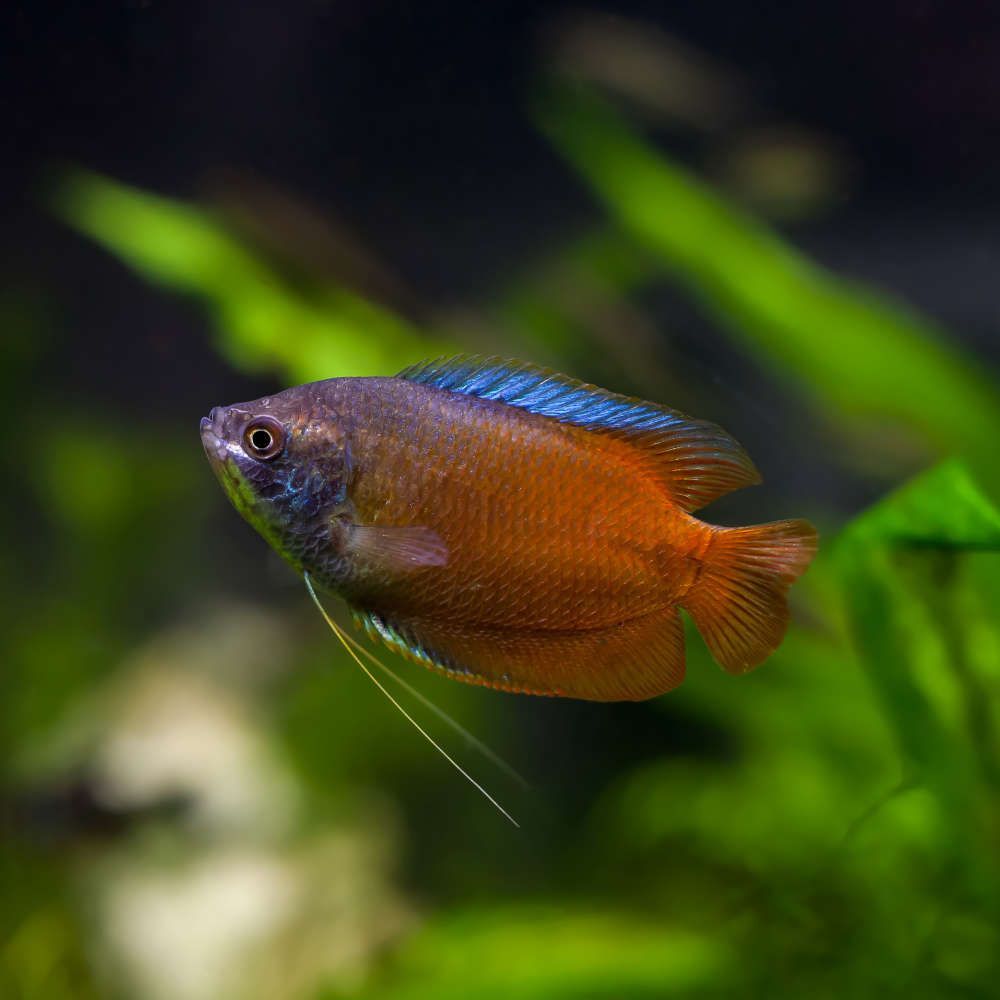
This gourami showcases a captivating blend of vivid orange and red hues. It’s one of the most popular dwarf gouramis.
What is the color of Neon Blue Dwarf Gourami?
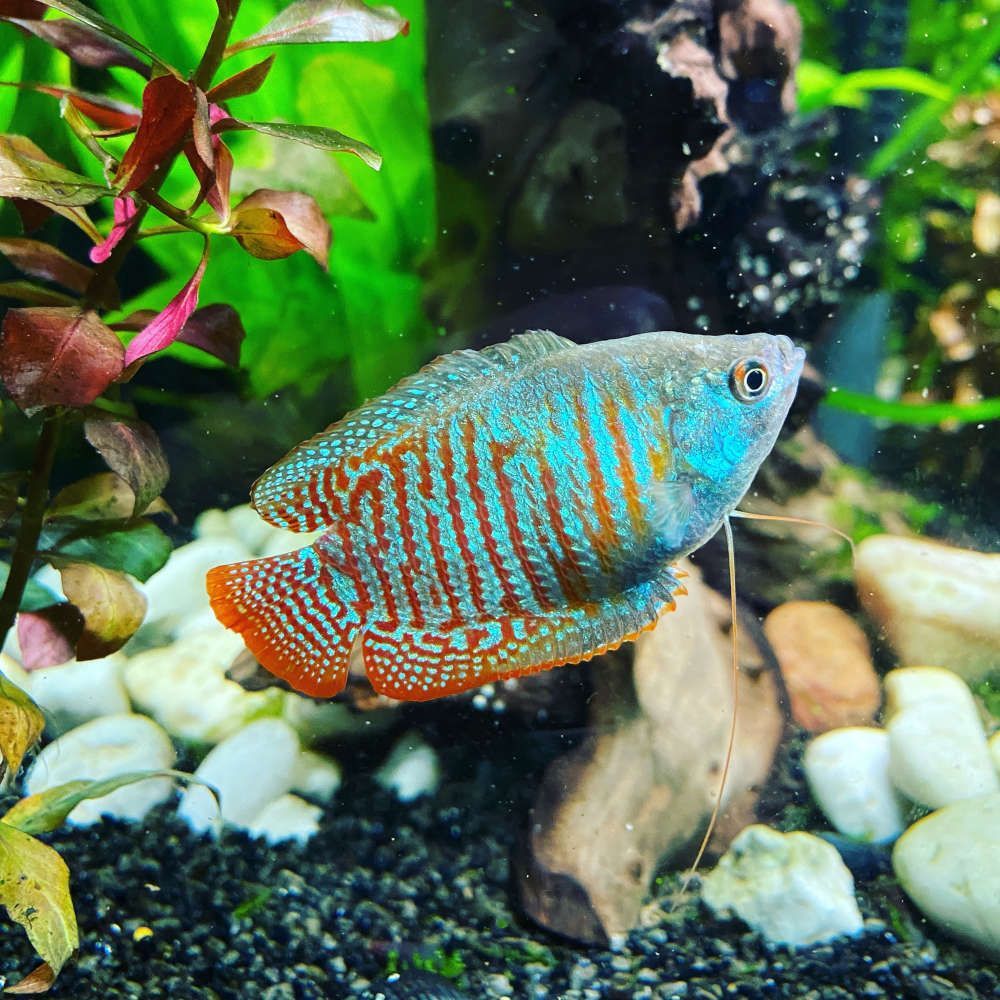
This variant stands out with its dazzling blue and vibrant colors, often accompanied by lively red stripes along its body. Its neon blue hue is even more striking than that of the standard blue dwarf gourami.
What are the Features of Dwarf Gourami?
The fish has a sleek, streamlined opioid-shaped hydrodynamic body. It has prominent and large dorsal and anal fins which get merged.
It can breathe both through its gills and a unique organ called the Labyrinth, which lets it take in air from above the water.
With its long ventral fins, like whiskers, it can sense its surroundings and measure distances from other fish or things in the water. These fins are touch-sensitive and help them navigate.
It also has antennae or palpi, which help it “taste” its food even before taking it into its mouth.
Is there any difference between a male and female Dwarf Gourami?
The mature male dwarf gourami is larger, slender, and more vibrant than the plain, silvery, and rounder adult females.
Males also have extended dorsal and anal fins with pointed tips, while females have shorter and rounded fins.
What is the behavior of Dwarf Gourami in an aquarium?
Dwarf gouramis are diurnal species that are usually peaceful around different species. But they can get a bit territorial, especially with their own kind.
Until they figure out their ranks or pecking order, they might show off or have small disagreements.
Males can sometimes be too tough on females, causing stress or even harming them.
What is the Lifespan of Dwarf Gourami?
Usually, the fish lives up to 3 years. In my experience, this can be stretched to 4 years with ideal care. Stress, inadequate diet, and poor conditions can shorten their lifespan.
Author’s Note: The fish is sensitive to noise and stress. Therefore place the tank in a quiet environment to keep them happy and healthy.
How to Take Care of Dwarf Gourami?
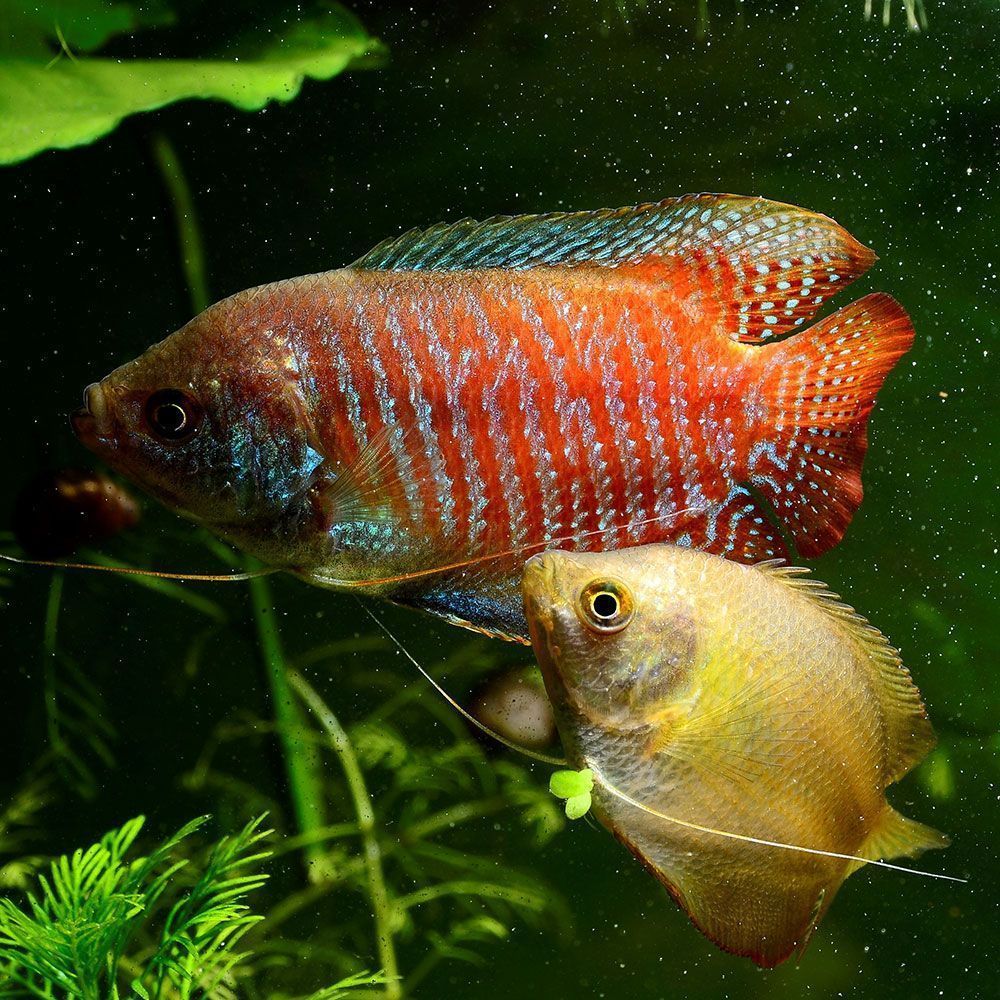
If you’re excited to have this fish in your tank, let’s explore the proper care guidelines to ensure its well-being!
What is the Tank Size for Dwarf Gourami?
A single dwarf gourami needs a minimum tank size of 15 gallons. For two, use a 30-gallon tank. If you wish to add more fish, add 10 gallons per new fish.
What should the Water Chemistry be for Dwarf Gourami?
To keep your dwarf gouramis healthy, make sure the water parameter is stable. These are ideal water conditions for them:
- pH Levels: 6-7.5
- Water Temperature: 72-82 °F (22-28 °C)
- Water Hardness: 4-13 dGh
- Ammonia: 0 ppm
- Nitrite: 0 ppm
- Nitrate: Below 15 ppm
What is the Tank Environment for Dwarf Gourami?
The aquarium’s environment impacts the mood and health of your pet fish. So, here’s how you can create optimal surroundings!
Does Dwarf Gourami need Substrate?
The naturally timid dwarf gourami fish prefers dark sand to feel calm and protected. The dark substrate will also help in showing off its vibrant colors.
Which Plants does Dwarf Gourami need in the tank?
Dwarf gourami loves a well-planted tank, just like its natural habitat. Plants are crucial for gouramis’ happiness and breeding. They also create hiding spots and shaded areas to ease stress and encourage their natural behaviors.
Choose rooted and floating plants to provide shade, hiding, rest, and nest spots. Here are some recommendations for this tank.
- Hygrophila
- Amazon frogbit
- Water lettuce
- Hornwort
- Cryptocoryne wendtii
- Java fern
- Amazon sword
- Water wisteria
- Vallisneria
- Salvinia
- Java moss
- Water sprite
- Hornwort
- Crystalwort
- Ludwigia repens
- Anubias nana
- Duckweed
- Red root floater
Make sure not to overpopulate the tank with floating plants since they need open space at the surface to breathe air.
What type of Lighting does Dwarf Gourami need around itself?
Dwarf gouramis prefer natural lighting. Artificial light is a must for heavily planted tanks. Opt for a dimmed or adjustable LED aquarium light and keep it on for 8-10 hours arrangement. Avoid strong lighting that might disturb the fish.
What is the décor required for Dwarf Gourami?
Incorporate natural elements like twigs, branches, leaf litter, small caves, and driftwood to provide cover. These establish a secure resting and hiding space.
Does Dwarf Gourami need Filtration in the tank?
This species can do well in a filter-less tank with proper attention. Instead, use live aquarium plants to oxygenate the water and remove toxins through photosynthesis.
Use an air pump to maintain oxygen levels. It produces bubbles that rise to the surface, promoting gas exchange by expelling carbon dioxide and infusing oxygen.
Perform regular water changes (10-20% weekly) as they are crucial to prevent harmful ammonia spikes resulting from fish waste accumulation.
If frequent maintenance is difficult, use an air stone along with an air pump to replicate some filtration benefits.
However, if the above is not feasible for you, choose a quality canister or hang-on back filter. For smaller tanks, gentle sponge filters work well.
Do Dwarf Gourami like fast water flow in the aquarium?
Dwarf gouramis don’t like fast or turbulent water. It’s best to keep the water flow stagnant to slow.
Fish Care Tip: Loud noises frighten dwarf gouramis, and they can get stuck and trapped in hard-to-reach places when they hide. So, regularly inspect the aquarium and check the number of specimens regularly.
What does Dwarf Gourami eat?
Dwarf gouramis are versatile omnivores and enjoy a mix of foods. In their natural habitat, they feast on small bugs, larvae, and algae.
In a tank, offer a well-balanced diet with 2-3 feedings a day of the following…
- Flakes
- Pellets
- Freeze-dried bloodworms
- Freeze-dried brine shrimp
- Daphnia
- Mysis shrimp
- Tubifex worms
- Spirulina
- Vegetable matter (such as blanched zucchini, spinach, or peas)
- Live blackworms
- Micro pellets
- Small insects like fruit flies
- Algae wafers
- Mosquito larvae
- Baby brine shrimp
- Microorganisms (infusoria, paramecia)
- Gel-based foods
- Crushed fruits (like apples or pears)
- Chopped earthworms
Be cautious of their faster eating habits. They might outcompete slower fish during meals.
Keep an eye on their color and adjust their diet as needed. Dwarf gouramis may even use their ventral fins to locate food at times.
What are the Tank Mates for Dwarf Gourami?
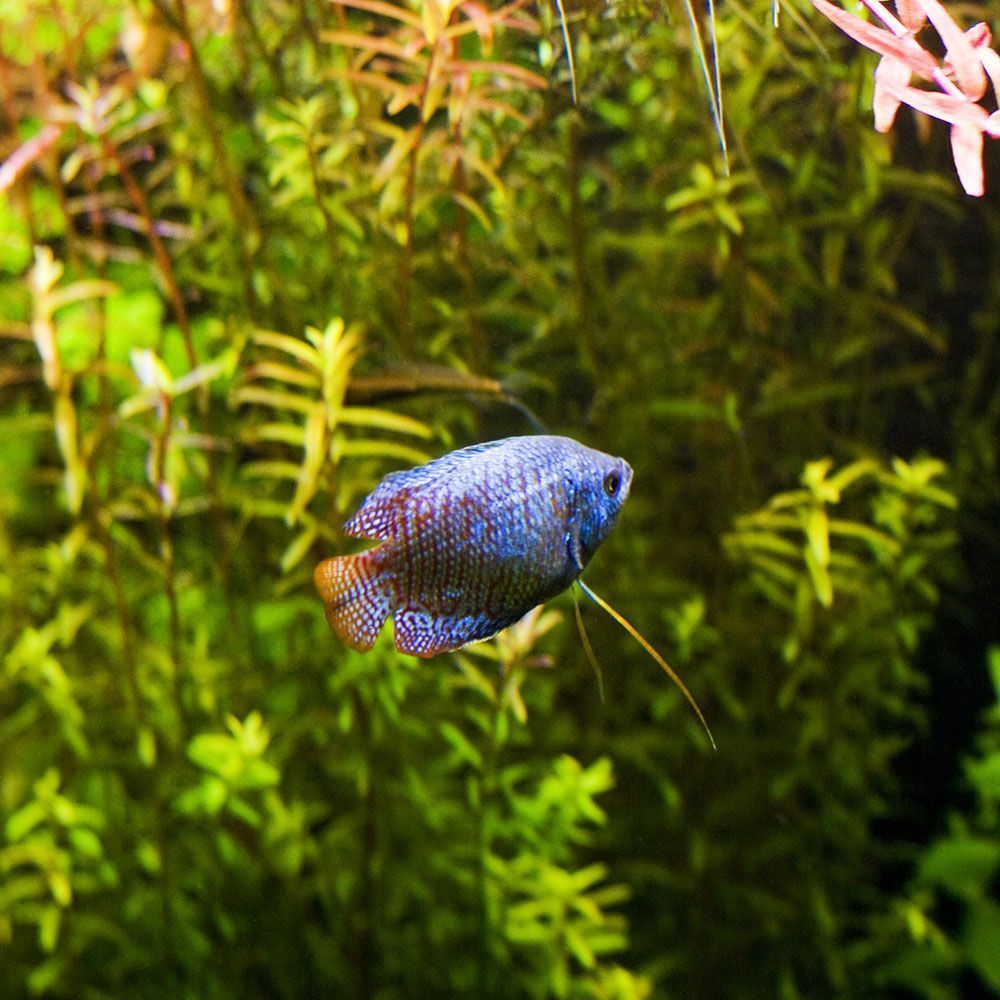
Dwarf gourami is most compatible with similarly sized or smaller fish with a harmonious temperament. They live comfortably with bottom-dwelling, non-territorial neighbors.
The ideal tank mates for it are:
- Common Plecos
- Tetras
- Loaches
- Catfish (Corydoras and Otocinclus)
- Swordtail fish
- Rasboras
- Mollies
- Barbs
- Smaller rainbowfish
- Peaceful cichlids (in larger setups)
- Platy fish
- Cherry shrimps
Which Tank Mates to Avoid for Dwarf Gourami?
Steer clear of species that might disrupt its peaceful and shy nature. Here’s a list of tank mates to avoid and reasons for their incompatibility:
- Large aggressive fish (e.g., cichlids, oscars): They may intimidate or harm this species due to their size and aggressive behavior.
- Fast-swimming species (e.g., tiger barbs): Active swimmers can stress out this fish and create unnecessary competition for food and space.
- Fin-nipping fish: They can injure this fish and disturb its well-being.
- Territorial fish: They can stress dwarf gouramis.
- Large predatory fish (e.g., oscars): They may view this fish as potential prey, endangering its safety.
- Goldfish: They have different tank requirements and may beat this fish for resources.
What are the Common Diseases associated with Dwarf Gourami?
Dwarf gourami is quite hardy and tolerant with good care. But be mindful of certain conditions that can impact their well-being.
| Disease Name | Causes | Symptoms | Treatment |
|---|---|---|---|
| Bloated Dwarf Gourami Disease (Iridovirus) | Immune deficiency due to genetic disorders. | Fading color, reduced activity, sores, bloating. | Supportive care, quarantine, antibiotics (for secondary infections) |
| Pseudomoniasis | Pathogenic bacteria | Dark spots turn into red sores and abscesses on the body | Dilute Bicillin-5 in water, potassium permanganate baths |
| Fin Rot | Bacterial Infection | Sluggishness, reduced appetite, frayed or disintegrated fins, and changes in fin color. | Improve water quality, eliminate objects that may cause physical injuries, use antibiotics |
| Ich | External Protozoan Parasite | Sluggishness, reduced appetite, pale patches, erratic swimming behavior | Add ich medicines or aquarium salts, raise aquarium temperature |
| Columnaris | Bacterial Infection | Sluggishness, decreased hunger, pale spots, frayed fins | Elevate water quality, use antibiotics, reduce stress |
| Infectious Dropsy | Pathogen entry from contaminated and food | Scales bulging, loss of appetite, fish lying at the bottom | Antibiotics, potassium permanganate baths, chloramphenicol |
| Ecto and Endoparasites | Parasitic infections. | Holes, abscesses, and rashes in the fins and body. | Separate tank, water parameter tests, identify source, treat visible wounds, use appropriate medications |
| Obesity | Unhealthy and unbalanced diet | Swollen belly, decreased activity, loss of appetite | Adjust diet, fast your fish |
| Reddened fins | Increased nitrogen and toxin levels. | Fins Turned Red | Improve water conditions, proper dosing of medication. |
| Peeling scales | Physical damage, infections, osmotic stress | Bald spot on fish body | Treat wounds, maintain water balance |
| Fish floating on the surface | Lack of oxygen, poor water quality, respiratory issues | Fish floating and gasping for air | Improve aeration, water quality, and oxygen levels. |
| Red Spots | External wounds, internal abnormalities | Lesions, ulcers. | Antibiotics, salt baths, chloramphenicol. |
| Alkalosis | High alkalinity leads to elevated pH levels in the water. | Restlessness, nervousness, rapid breathing, discoloration, white mucus | Transfer fish into a tank with 7.5-8 pH to gradually restore normal conditions |
| Acidosis | Low pH levels (high acidity) in the water | Fish swimming in circles, seeking isolation, releasing white mucus due to anxiety | Decrease water acidity by adjusting pH levels |
| Ichthyobodo (Costia) Infection | Parasitic infection | Fins stick together, white mucus, flashing, rubbing against surfaces, blue spots, anxiety | Bath with penicillin-5, malachite green, salt, methylene blue, hydrochloride |
| Chlorosis | Chlorine exposure or other water quality issues | Brightened color, anxiety, fear, white mucus on scales, decreased responsiveness | Clean water. Monitor chlorine levels in the tank |
| Swollen belly | Tapeworms, overfeeding | Swollen abdomen, decreased activity, loss of appetite | Administer fish anthelmintic, adjust diet, fasting |
| Poor appetite | New environment stress, diet change, illness | Spitting out food, rejecting food | Quarantine new fish, adjust diet, check for foreign bodies |
Quick Tip: Properly clean or quarantine any decor or fish you want to add to an established tank before introduction.
How to breed Dwarf Gourami?
Successful breeding of dwarf gourami in home aquariums depends on factors like water quality, temperature, and the behavior of the fish.
If you’re patient and ready to take on this challenge, here’s all you need to try it!
Is Separate Breeding Aquarium Setup needed for Dwarf Gourami?
Create a separate 30-gallon breeding tank to prevent potential disruptions from other fish in the main tank, ensuring a calm and controlled environment for breeding activities.
This increases the chances of observing their fascinating courtship rituals and the successful development of eggs and fry.
Use a thin layer of sand to mimic their natural environment. Introduce specific aquatic plants like ambulia, crystalwort, water sprite, java moss, hornwort, and riccia to provide hiding spots and surfaces for bubble nest attachment.
Additionally, offering peat fiber as a building material further enhances the male’s ability to construct a robust bubble nest.
Ensure subdued lighting with a day-night cycle but adequate for the growth of aquatic plants that contribute to bubble nest construction.
Fit a tightly-fitting tank cover or clingfilm to maintain a layer of warm, humid air above the water. This helps in the development of the labyrinth organ in the fry.
How should be the aquarium water for breeding Dwarf Gourami?
Use a small gentle air-driven sponge filter and avoid strong water currents as they might damage the bubble nest. The filter must not disrupt the nest or the breeding pair.
Maintain the following water parameters:
- Water Temperature: 80-84°F (27-29°C) [avoid drastic temperature fluctuations to avoid disruption in breeding]
- pH Levels: 6.0-7.0
- Water Hardness: 4-10 dGH
- Carbonate hardness: 2-6 dKH
- Ammonia: 0 ppm
- Nitrites: 0 ppm
- Nitrate: below 20 ppm
Perform regular partial water changes (around 20-30% every week) to help maintain water quality and stable parameters. Ensure the new water added is appropriately conditioned and matches the tank’s temperature.
Bubble Nest Construction & Materials
Male Dwarf Gouramis construct bubble nests using plant materials, twigs, and bubbles. To facilitate successful nest building, lower the water levels to about 7-10 cm (3-4 inches) during spawning.
Ideal Mating Conditions: Male-to-Female Ratio
Maintain an appropriate male-to-female ratio to encourage successful mating behavior in dwarf gouramis. Otherwise, it can lead to stress or aggression among the fish.
Place one male for every two or three females to stimulate natural courtship behaviors and better chances for successful egg fertilization.
Condition the specimens with live food, such as worms.
How do Dwarf Gourami Mate?
During courtship, the male swims around the female with fins flared and entices her to the bubble nest.
A noticeable sign of a female’s readiness to release eggs is her plump appearance. She often swims in circles with the male beneath the bubble nest, indicating her willingness to spawn.
If the female accepts the male fish’s advances, they engage in an elaborate courtship dance beneath the nest.
She gently touches the male, usually on his back or tail, with her mouth. This touch triggers the male to wrap his body around the female, releasing sperm.
The female releases approximately five dozen clear eggs, and the male collects them. He fertilizes them and places them in the bubble nest. The process may repeat multiple times.
Egg Characteristics & Hatching
The eggs are transparent and buoyant. They float upwards and get caught in the bubble nest.
Hatching occurs between 12 to 24 hours after egg deposition. The exact timing may vary based on factors such as water temperature and overall tank conditions.
How do Dwarf Gourami Eggs Survive in the Tank?
The bubble nest offers a protective haven for the eggs, shielding them from potential threats within the tank.
Some eggs might still stray from the nest. The male gathers any straying eggs and carefully places them back into the nest.
Poor water quality, aggression, or disturbances on the bubble nest from other specimens can act as threats to the eggs.
What should be done Post-Spawning for Dwarf Gourami Breeding?
After spawning, move all females to a separate tank. This ensures her safety and prevents potential conflicts with the territorial male, who now takes sole responsibility for guarding the eggs and the nest.
The male exhibits protective behavior and may become aggressive to defend his territory.
Fry Development & Care
Upon hatching, hundreds of tiny fry become noticeable within the bubble nest. Once hatched, the tiny fry remains within the bubble nest for approximately three days.
During this time, the male guards and cares for the vulnerable fry and creates a conducive environment for their early development.
Feeding & Fry Growth
After a few days, feed the fry infusoria, powdered fry food, and micro worms, which provide essential nutrients during their early stages of development.
As the fry grows, their diet can be supplemented with brine shrimp and finely crushed flakes.
When should you transfer the Dwarf Gourami Fry to Main Tank?
Once the fry reach 1.5-2 cm (0.6-0.8 in), introduce them to the main tank. This transition requires careful monitoring to ensure the fry’s successful integration and interaction with other fish in the tank.
Breeding Tip: Test the water of your breeding tank regularly to ensure a healthy environment. Watch out for elevated levels of harmful compounds like ammonia, nitrate, and nitrite, which can cause harm to the breeding pair, eggs, and fry.
How many Dwarf Gourami should you buy for aquarium?
Usually, dwarf gouramis are sold in pairs, with one male and one female, because it is the ideal choice for home aquariums. Two males can be a problem unless you have a very big tank.
Even if you have a male and female, sometimes the male exhibit aggression toward the female.
A ratio of three females to one male is advisable. Aim for a group of at least 7 or 10 individuals when you are buying these species.
Buy fish that shows a strong appetite, energetic movement near the water’s surface, absence of wounds or unusual protrusions, and vibrant scale hues.
Avoid fish with white spots, irregular markings, cloudy or swollen eyes, or resting at the tank bottom.
A word from FishInAquarium
Dwarf gouramis exhibit unique personalities which add life to your tank. They are pretty fun to feed because of their great appetite and are also available in a wide range of colors.
If you found this article helpful, feel free to share it with others who would value the information.
If you have any more questions or need further assistance, please don’t hesitate to reach out to us via email. Our team members are here to help and guide you through!

